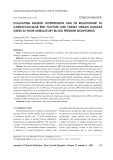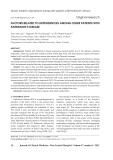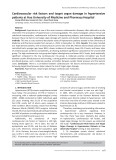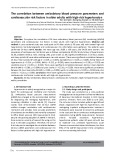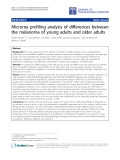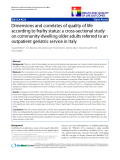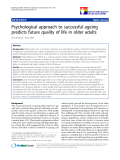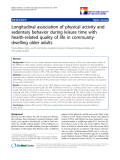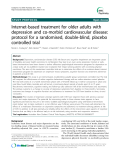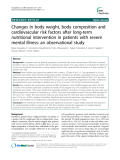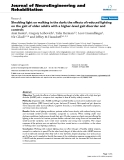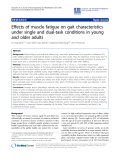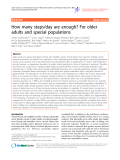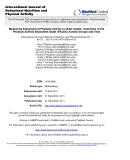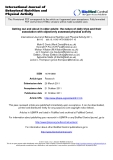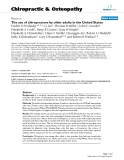
HUE JOURNAL OF MEDICINE AND PHARMACY ISSN 1859-3836
34
Hue Journal of Medicine and Pharmacy, Volume 13, No.6-2023
The correlation between ambulatory blood pressure parameters and
cardiovascular risk factors in older adults with high-risk hypertension
Tran Van Nam1, Hoang Huy Truong2*, Le Thi Bich Thuan3
(1) Department of Internal Medicine, Becamex International Hospital, Binh Duong province, Vietnam
(2) Department of Internal Medicine, Faculty of Medicine, Pham Ngoc Thach University of Medicine,
Ho Chi Minh City, Vietnam
(3) Department of Internal Medicine, Hue University of Medicine and Pharmacy, Hue University,
Hue city, Thua Thien Hue province, Vietnam
Abstract
Objective: To explore the correlation of 24-hour ambulatory blood pressure (BP) monitoring (ABPM)
parameters and cardiovascular risk factors in older adults with high-risk hypertension. Material and
method: A cross-sectional study was conducted on 96 older adults (≥ 60 years old) with treated high-risk
hypertension. Socio-demographic and cardiovascular risk information were gathered. The patients were
performed 24-hour ABPM. Results: The mean age was 70.88 ± 7.86 years, and 64.6% were women. The
prevalence of cardiovascular risk factors was as follows: dyslipidemia: 80.2%, family history of hypertension:
54.2%, diabetes mellitus: 51%, smoking: 24%, prior stroke: 11.5%. Significant differences in 24-hour, awake,
and sleep systolic BP were observed between men and women. There were significant correlations between
24-hour mean systolic BP with age (r = 0.229, p = 0.025), dyslipidemia (r = 0.223, p = 0.029), family history of
hypertension (r = 0.214, p = 0.036), BMI (r = 0.212, p = 0.039), waist circumference (r = 0.226, p = 0.027) and
creatinine level (r = 0.207, p = 0.043). There were significant correlations between 24-hour mean diastolic
BP with BMI (r = 0.289, p = 0.004) and prior stroke (r = -0.224, p = 0.029). There were significant correlations
between 24-hour mean BP with BMI (r = 0.268, p = 0.009), waist circumference (r = 0.220, p = 0.032) and prior
stroke (r = -0.215, p = 0.036). Conclusion: There were significant correlations between ABPM parameters and
cardiovascular risk factors in older adults with high-risk hypertension.
Keywords: 24-hour ambulatory blood pressure, cardiovascular risk factors, high-risk hypertension, older
adults, correlation.
Corresponding author: Hoang Huy Truong. E-mail: truonghh@pnt.edu.vn
Recieved: 14/7/2023; Accepted: 12/12/2023; Published: 31/12/2023
DOI: 10.34071/jmp.2023.6.4
1. INTRODUCTION
Hypertension is widely recognized as a major risk
factor for cardiovascular morbidity and mortality
[1]. Ambulatory blood pressure measurement
(ABPM) has emerged as the recommended method
for diagnosing and managing hypertension, with
increasing utilization in older adults [2]. Previous
studies have demonstrated that 24-hour ABPM
exhibits stronger correlations with cardiovascular
risk factors and provides more accurate predictions
of cardiovascular morbidity and mortality compared
to office blood pressure (BP) measurements [3,4].
Despite the growing adoption of ABPM in Vietnam,
there remains a scarcity of research focusing on this
issue in the older population. Therefore, the aim of
this study was to investigate the correlation between
24-hour ABPM parameters and cardiovascular risk
factors in older patients with high-risk hypertension.
2. MATERIALS AND METHODS
2.1. Study design and participants
The study was conducted as a cross-sectional
investigation at the Department of Internal Medicine
of Becamex International Hospital in Binh Duong
province, Vietnam, from June 2020 to June 2021.
The inclusion criteria included patients aged 60 and
above, diagnosed with high-risk hypertension, and
undergoing inpatient antihypertensive treatment.
Participants were required to consent to participate
in the study and be on continuous antihypertensive
medication during ABPM measurements. Exclusion
criteria included secondary hypertension,
hypertensive patients under 60 years old with low
to moderate risk, untreated hypertension, acute
illnesses or severe electrolyte disturbances, less than
85% of the ABPM measurement time completed,
and non-consenting individuals.





